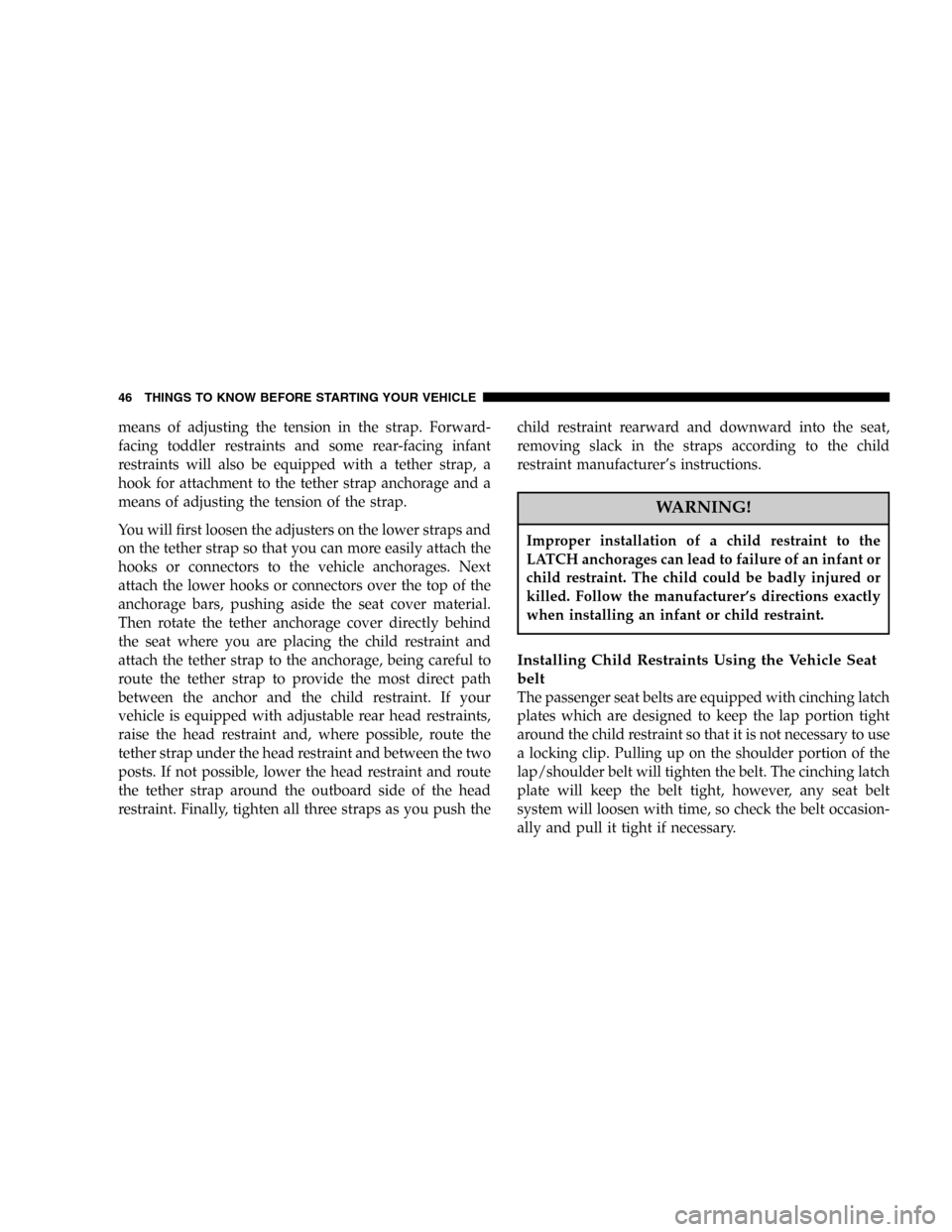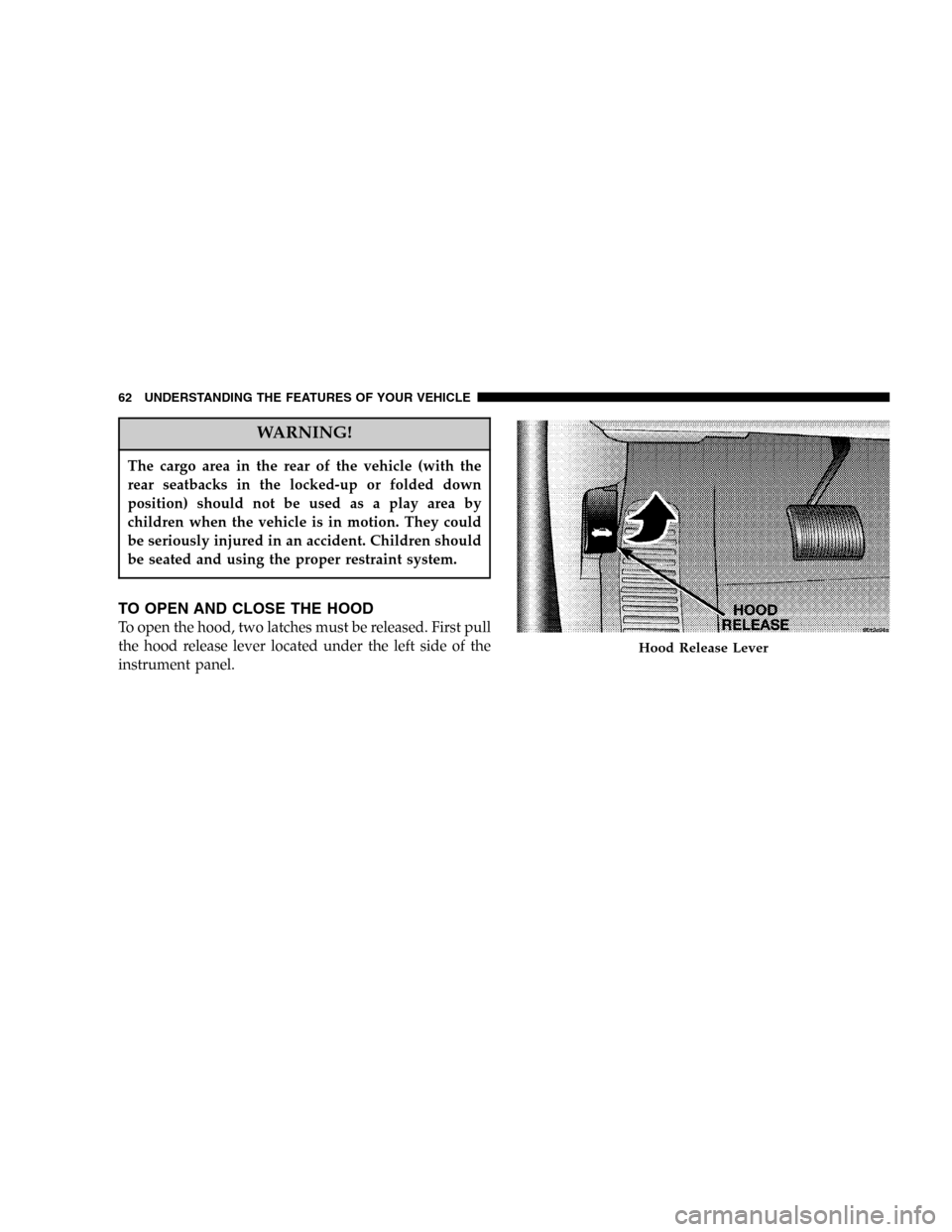2005 DODGE STRATUS child restraint
[x] Cancel search: child restraintPage 45 of 293

share a common lower anchorage. If you are installing
LATCH-compatible child restraints in adjacent rear seat-
ing positions, you can use the LATCH anchors or the
vehicle’s seat belt for the outboard position, but you must
use the vehicle’s seat belt at the center position. If your
child restraints are not LATCH-compatible, you can only
install the child restraints using the vehicle’s seat belts.
Please refer to the next section for typical installation
instructions.Installing the LATCH-Compatible Child Restraint
System
We urge that you carefully follow the directions of the
manufacturer when installing your child restraint. Not all
child restraint systems will be installed as described here.
Again, carefully follow the installation instructions that
were provided with the child restraint system.
The rear seat lower anchorages are round bars, located at
the rear of the seat cushion where it meets the seat back,
and are just visible when you lean into the rear seat to
install the child restraint. You will easily feel them if you
run your finger along the intersection of the seatback and
seat cushion surfaces.
In addition, there are tether strap anchorages
behind each rear seating position located in the
panel between the rear seat back and the rear
window. These tether strap anchorages are
under a hinged plastic cover with this symbol on it.
Many, but not all restraint systems will be equipped with
separate straps on each side, with each having a hook or
connector for attachment to the lower anchorage and a
LATCH Anchorages
THINGS TO KNOW BEFORE STARTING YOUR VEHICLE 45
2
Page 46 of 293

means of adjusting the tension in the strap. Forward-
facing toddler restraints and some rear-facing infant
restraints will also be equipped with a tether strap, a
hook for attachment to the tether strap anchorage and a
means of adjusting the tension of the strap.
You will first loosen the adjusters on the lower straps and
on the tether strap so that you can more easily attach the
hooks or connectors to the vehicle anchorages. Next
attach the lower hooks or connectors over the top of the
anchorage bars, pushing aside the seat cover material.
Then rotate the tether anchorage cover directly behind
the seat where you are placing the child restraint and
attach the tether strap to the anchorage, being careful to
route the tether strap to provide the most direct path
between the anchor and the child restraint. If your
vehicle is equipped with adjustable rear head restraints,
raise the head restraint and, where possible, route the
tether strap under the head restraint and between the two
posts. If not possible, lower the head restraint and route
the tether strap around the outboard side of the head
restraint. Finally, tighten all three straps as you push thechild restraint rearward and downward into the seat,
removing slack in the straps according to the child
restraint manufacturer’s instructions.
WARNING!
Improper installation of a child restraint to the
LATCH anchorages can lead to failure of an infant or
child restraint. The child could be badly injured or
killed. Follow the manufacturer’s directions exactly
when installing an infant or child restraint.
Installing Child Restraints Using the Vehicle Seat
belt
The passenger seat belts are equipped with cinching latch
plates which are designed to keep the lap portion tight
around the child restraint so that it is not necessary to use
a locking clip. Pulling up on the shoulder portion of the
lap/shoulder belt will tighten the belt. The cinching latch
plate will keep the belt tight, however, any seat belt
system will loosen with time, so check the belt occasion-
ally and pull it tight if necessary.
46 THINGS TO KNOW BEFORE STARTING YOUR VEHICLE
Page 47 of 293

In the rear seat, you may have trouble tightening the
lap/shoulder belt on the child restraint because the
buckle or latch plate is too close to the belt path opening
on the restraint. Disconnect the latch plate from the
buckle and twist the short buckle-end belt several times
to shorten it. Insert the latch plate into the buckle with the
release button facing out.
If the belt still can’t be tightened, or if by pulling and
pushing on the restraint loosens the belt, you may need
to do something more. Disconnect the latch plate from
the buckle, turn the buckle around, and insert the latch
plate into the buckle again. If you still can’t make the
child restraint secure, try a different seating position.
Child restraint tether strap attachment
1. Rotate the cover over the anchor directly behind the
seat where you are placing the child restraint.2. Route the tether strap to provide the most direct path
for the strap between the anchor and the child seat. If
your vehicle is equipped with adjustable rear head
restraints, raise the head restraint and, where possible,
route the tether strap under the head restraint and
between the two posts. If not possible, lower the head
restraint and pass the tether strap around the outboard
side of the head restraint.
Tether Strap Mounting
THINGS TO KNOW BEFORE STARTING YOUR VEHICLE 47
2
Page 48 of 293

3. Attach the tether strap hook (A) of the child restraint
to the anchor (B) and remove slack in the tether strap
according to the child restraint manufacturer’s instruc-
tions.
WARNING!
An incorrectly anchored tether strap could lead to
increased head motion and possible injury to the
child. Use only the anchor positions directly behind
the child seat to secure a child restraint top tether
strap.
Transporting Pets
Airbags deploying in the front seat could harm your pet.
An unrestrained pet will be thrown about and possibly
injured, or injure a passenger during panic braking or in
a collision.
Pets should be restrained in the rear seat in pet harnesses
or pet carriers that are secured by seat belts.
ENGINE BREAK-IN RECOMMENDATIONS
The engine in your new vehicle does not require a long
break-in period.
Drive moderately during the first 300 miles (500 km).
After the initial 60 miles (100 km), speeds up to 50 or 55
mph (80 or 90 km/h) are desirable.
While cruising, brief full-throttle acceleration, within the
limits of local traffic laws, contributes to a good break-in.
Wide open throttle acceleration in low gear can be
detrimental and should be avoided.
The crankcase oil installed in the engine at the factory is
a high quality energy conserving type lubricant. Oil
changes should be consistent with expected climate con-
ditions under which vehicle operations will occur. The
recommended viscosity and quality grades are in Section
7 of this manual.
Do not use non-detergent or straight mineral oils.
A new engine may consume some oil during its first few
thousand miles of operation. This is a normal part of the
break-in and not an indication of a problem.
48 THINGS TO KNOW BEFORE STARTING YOUR VEHICLE
Page 62 of 293

WARNING!
The cargo area in the rear of the vehicle (with the
rear seatbacks in the locked-up or folded down
position) should not be used as a play area by
children when the vehicle is in motion. They could
be seriously injured in an accident. Children should
be seated and using the proper restraint system.
TO OPEN AND CLOSE THE HOOD
To open the hood, two latches must be released. First pull
the hood release lever located under the left side of the
instrument panel.
Hood Release Lever
62 UNDERSTANDING THE FEATURES OF YOUR VEHICLE
Page 282 of 293

Charging System Light................... 90
Chart, Tire Sizing....................... 156
Check Engine Light
(Malfunction Indicator Light).............. 204
Checking Your Vehicle For Safety............ 49
Child Restraint...................41,43,45,46
Child Restraint Tether Anchors............. 45
Child Safety Locks....................... 18
Cigar Lighter........................... 98
Circuit Breakers........................ 235
Clean Air Gasoline...................... 174
Cleaning
Glass.............................. 233
Headlights.......................... 233
Instrument Panel..................... 234
WoodTrim .......................... 234
Climate Control........................ 125
Clock................................. 98
Coin Holder........................... 54
Compact Disc Changer................... 119
Compact Disc Maintenance............... 124
Compact Disc Player.................100,105
Compact Spare Tire..................... 166Compass.............................. 95
Compass Calibration..................... 96
Contract, Service....................... 272
Coolant Pressure Cap.................... 223
Cooling System........................ 220
Adding Coolant (Antifreeze)............. 223
Coolant Capacity..................... 244
Coolant Level.....................221,224
Disposal of Used Coolant............... 224
Drain, Flush, and Refill................. 221
Inspection........................220,221
Points to Remember................... 224
Pressure Cap........................ 223
Radiator Cap........................ 223
Rubber and Plastic Components.......... 225
Selection of Coolant.............222,244,245
Corrosion Protection.................... 230
Crankcase Emission Control System......... 213
Cruise Control (Speed Control)............. 71
Cruise Light........................... 89
Customer Assistance.................... 270
Daytime Brightness, Interior Lights.......... 64
282 INDEX
Page 286 of 293

Ignition
Key ................................ 11
Lock................................ 11
Illuminated Entry....................... 15
Immobilizer............................ 13
Infant Restraint......................... 42
Inside Rearview Mirror................... 56
Instrument Cluster....................... 88
Instrument Panel and Controls.............. 87
Instrument Panel Cover.................. 234
Instrument Panel Lens Cleaning............ 234
Interior Appearance Care................. 232
Interior Fuses.......................... 235
Interior Lighting........................ 63
Interior Lights........................63,64
Introduction............................ 4
Jack Location.......................... 188
Jack Operation......................... 188
Jump Starting......................... 193
Key, Programming....................... 14
Key, Replacement....................... 14Key, Sentry............................ 13
Key-In Reminder........................ 12
Keyless Entry System..................... 19
Keys................................. 11
Knee Bolster........................... 34
Lap/Shoulder Belts...................... 27
LATCH
(Lower Anchors and Tether for CHildren)..... 45
Latch Plate............................ 28
Latches
Hood............................... 62
Lead Free Gasoline...................... 173
Leaks, Fluid............................ 50
Lights..............................50,63
Airbag........................38,41,49,89
Anti-Lock............................ 92
Automatic Headlights................... 66
Brake Warning.....................93,150
Bulb Replacement..................... 238
Check Engine......................... 90
Daytime Running...................... 67
Dimmer Switch, Headlight.............65,67
286 INDEX
Page 290 of 293

Safety Checks Inside Vehicle............... 49
Safety Checks Outside Vehicle.............. 50
Safety Defects, Reporting................. 274
Safety Information, Tire.................. 154
Safety Tips............................. 49
Schedule, Maintenance................... 249
Seat Belt Maintenance................... 234
Seat Belt Reminder...................... 32
Seat Belts.............................. 27
Adjustable Upper Shoulder Anchorage...... 31
And Pregnant Women.................. 33
Child Restraint....................41,42,46
Extender............................ 33
Front Seat............................ 28
Inspection........................... 49
Operating Instructions.................. 28
Pretensioners......................... 31
Reminder............................ 94
Seats................................. 59
Adjustment.......................... 59
Cleaning............................ 232
Head Restraints....................... 61
Lumbar Support....................... 60Power.............................. 60
Rear Folding......................... 61
Reclining............................ 59
Security Alarm (Theft Alarm)............... 23
Selection of Coolant..................222,245
Sentry Key.......................... 11,13
Service Assistance...................... 270
Service Contract........................ 272
Service Engine Soon Light (Malfunction Indicator)
..................................... 90
Service Manuals........................ 274
Setting the Clock........................ 98
Shoulder Belt Upper Anchorage............. 31
Side Airbag............................ 40
Side Window Demisters...............130,135
Signals, Turn........................... 90
Slippery Surfaces, Driving On............. 196
Snow Tires............................ 170
Spare Tire.........................166,167
Spark Plugs........................... 210
Speed Control........................71,89
Speedometer........................... 90
Starting.............................. 142
290 INDEX